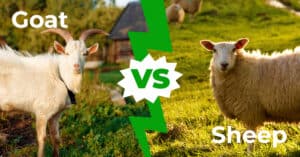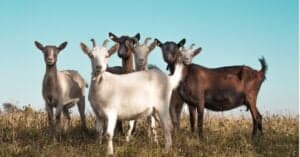Goats are no strangers to humans, with over 200 breeds of goats domesticated around the world today. These creatures are a fascinating species to observe, both domesticated and in the wild. While you may know quite a lot about goats, including the fact that their ‘kids’ look adorable, we have compiled 10 incredible goats facts that may surprise you.
1. Goats prefer smiling faces

Goats can read human body language and distinguish between our expressions.
©ANGHI/Shutterstock.com
Generally, goats can read human body language and distinguish between our expressions. However, a study reveals that these animals not only know how to identify our expressions, but they also have a preference. In the study, researchers displayed two versions of the same face in a goat sanctuary: one happy and one angry. The goats tended to avoid the angry face while exploring the happy one with their snouts. Therefore, one way to get your goats to feel comfortable around you will be to put on a smile.
2. Goats have been domesticated for a long time
Man and goats have had a long journey together, with goats being among the first livestock species to be domesticated by man about 10,000 years ago. In a study that was published in the year 2000, researchers found archeological evidence that the domestication of goats (Capra hircus) began about 10,000 years ago in the Fertile Crescent region of the Middle East. These goats were domesticated to provide milk, meat, fuel, and clothing for their owners – Neolithic farmers.
It is interesting to note, however, that regardless of being the earliest domesticated animals, goats will speedily revert to an untamed state if they are released into the wild.
3. Goats are not fans of the rain
Goats seek the nearest shelter at the hint of rain and will avoid being beaten at all costs. The animals simply do not like to get wet, no matter how hot the weather has been before then. The reason for this is not exactly clear, though it is mostly attributed to an innate instinct to avoid wet weather. It may be that something in goats tells them that wet hooves are bad, or they evolved to relate staying dry with lesser parasites to deal with.
4. Mountain goats can be addicted to human urine
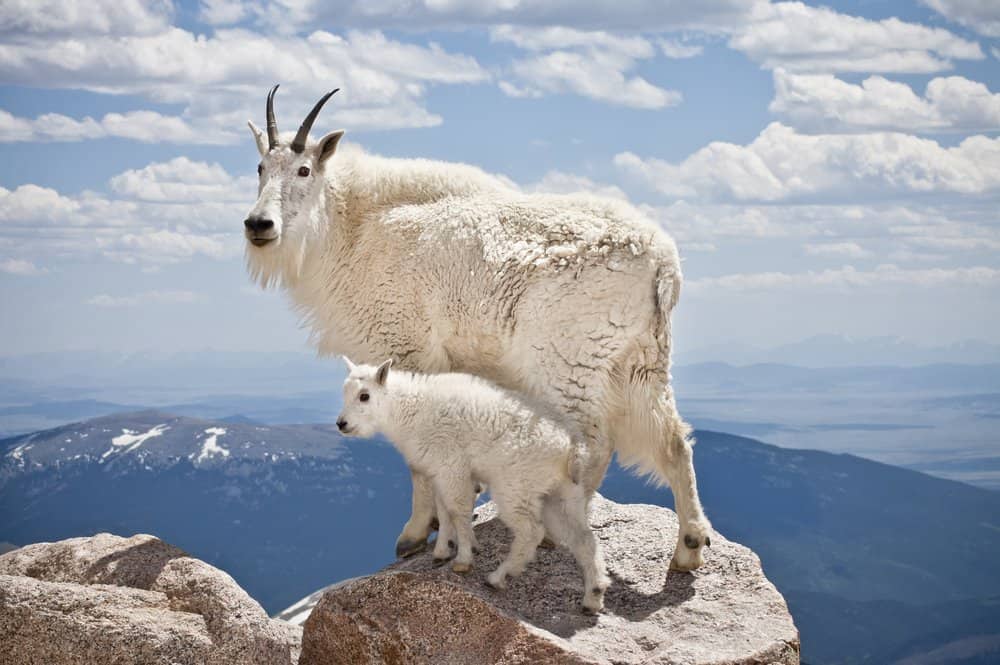
Mountain goats love human urine because it is a good source of salts and minerals.
©Joshua Schutz/Shutterstock.com
Mountain goats really love human urine because it is a good source of salts and minerals. Interestingly, the insatiable love for human urine led to the removal of mountain goats from the Olympic National Park. With many camp visitors reliving themselves at different spots, the resident mountain goats soon developed an addiction that made them paw and dig the earth at the camp. Authorities had to relocate them to sites where they had fewer human interactions.
Similar experiences have been reported from individual campers around the world where goats showed an insatiable love for human urine spots.
5. Goats play a part in human cultures, religions, and mythologies
Their most popular appearance in mythology is in Norse mythology, where two goats are in charge of pulling Thor’s chariot. However, apart from this popular appearance, goats are also a common sacrificial animal in many cultural and religious practices. For example, in ancient Babylonia, the sacrifice of a goat was used to combat disease. From ancient India to Greece and Rome, the goat had varying roles to play in mythology, culture, and religion.
6. Goats have rectangular-shaped pupils
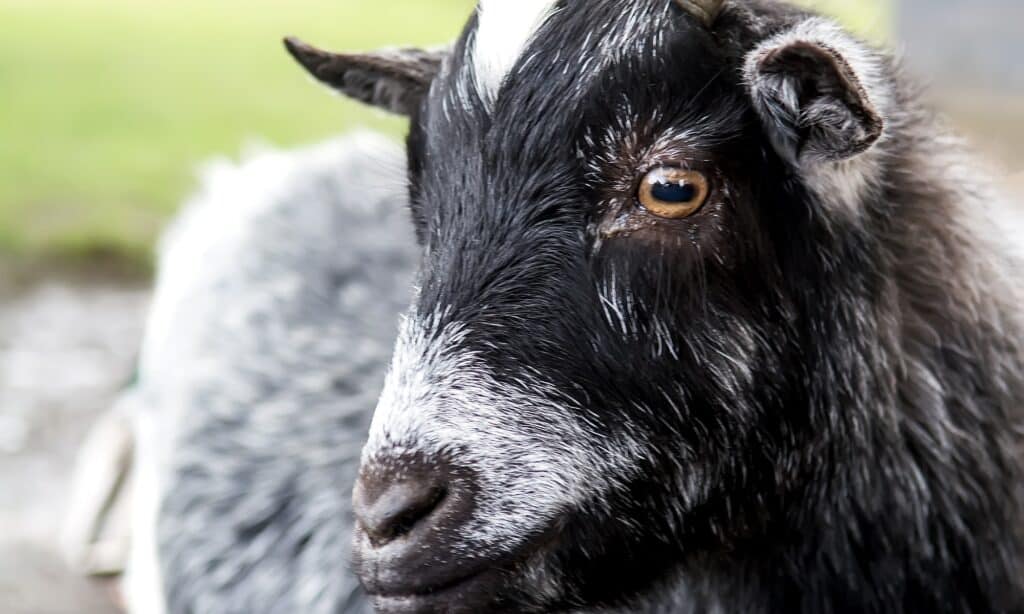
Through the possession of rectangular-shaped pupils, goats have excellent peripheral vision that helps them avoid predators in the wild.
©iStock.com/alisa24
Goats have an unusual pupil shape that ensures that they enjoy a broader and fuller look than humans and other animals that have round pupils. With their pupil flattened, goats have excellent peripheral vision that helps them avoid predators in the wild. In fact, the shape of their pupils means they can see almost everything except what is directly behind them.
The only seeming disadvantage to their pupil shape is that they have to move their heads to look up or down. However, we don’t think that they mind.
7. For goats, out of sight is not out of mind
For most non-primates, once an object is out of sight, they forget about its existence until they see it again or sniff it out. However, for goats, much like humans, it appears that out of sight is not out of mind. This ability is referred to as object permanence.
The fact that goats appeared to have a high stage of object permanence was discovered in an experiment carried out by a researcher using golden pasta. In the experiment, dwarf goats showed an uncanny ability to track hidden objects in a way that showed a high stage of object permanence that had not been observed in non-primates before then.
8. Goats are emotional and social creatures
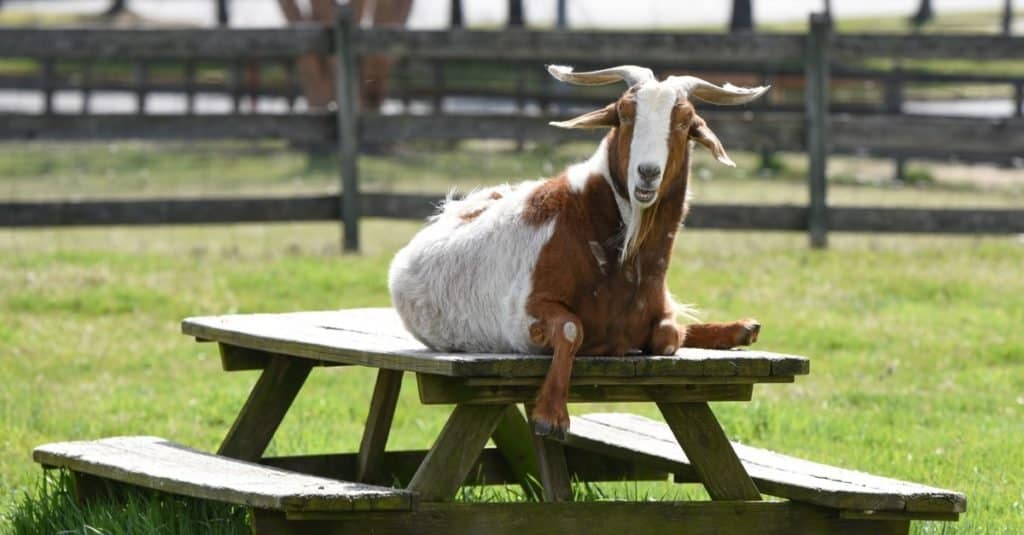
Goats can distinguish positive and negative calls from fellow goats.
©Gretchen Blair Madden/Shutterstock.com
This does not mean that your goat will burst into tears if you hurt its feelings. However, researchers have revealed that goats can distinguish positive and negative calls from fellow goats and have different physiological reactions based on what they hear.
For instance, an experiment carried out revealed that the time between goats’ heartbeats was greater for a positive call compared to a negative call. Another interesting proof that they are social and emotional creatures is that goats know the call of their friends from that of a strange goat they are not familiar with. This means they know how their friends look and sound. What other proof of good friendship do we need?
9. Goats have four stomachs
Goats have four stomach compartments that are incredibly useful in digesting tough food. The four compartments perform different functions in the entire digestive process. Their names are rumen, reticulum, omasum, and abomasum. The abomasum is closest to the human stomach in function, and it is usually referred to as the “true stomach.”
10. Goat milk is the most consumed milk in the world
It is likely you thought it was cow milk, but 65% to 72% of the milk consumed around the world is goat milk. The major reason for this is that it is far easier to rear goats than cows, especially in developing nations. However, in the US, cow milk is the most consumed type of milk.
The photo featured at the top of this post is © iStock.com/aurorat
Thank you for reading! Have some feedback for us? Contact the AZ Animals editorial team.




